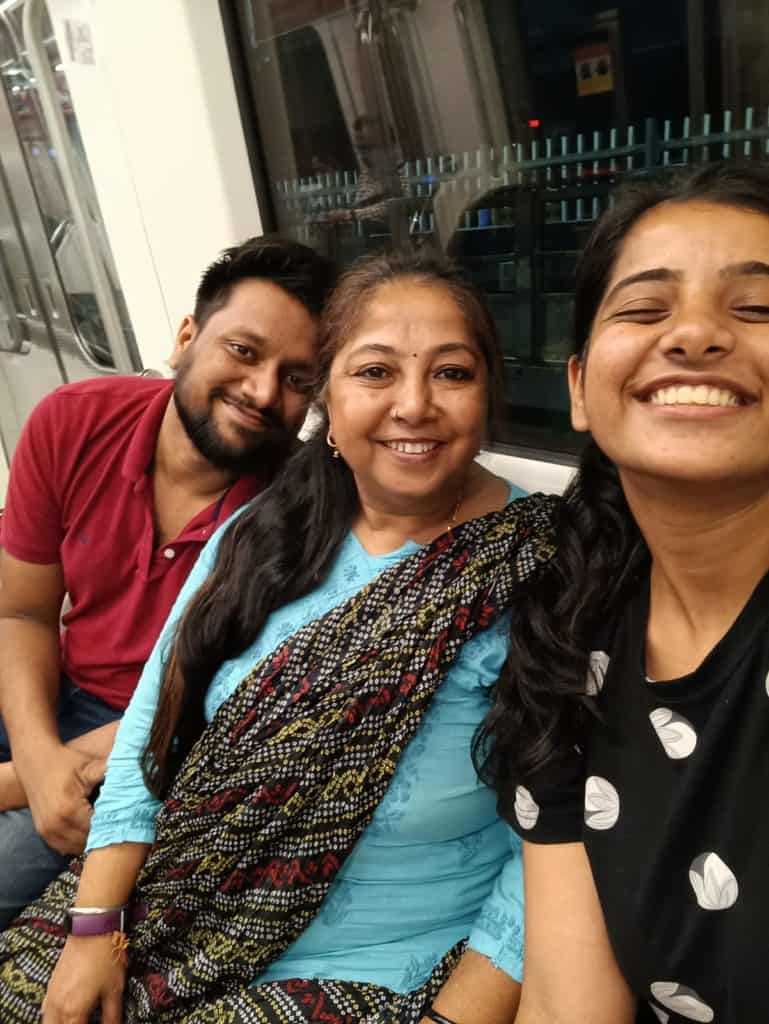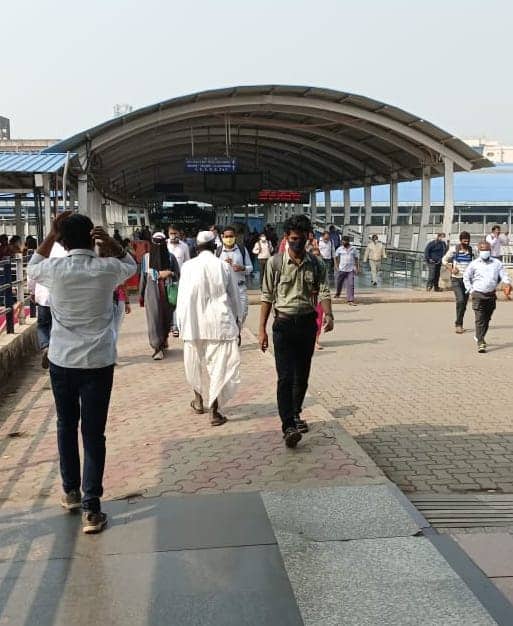Harshal Modi, a resident of Mumbai, has been using his scooter to travel to his factory everyday. After the state government reinstated the local trains, he hasn’t switched back to using them, citing issues with last mile connectivity from stations.
“It is more convenient to travel by scooter because there’s no issue of waiting for an auto to reach the station and vice versa. It takes such a long time to get an auto in Mumbai,” says Modi.
As the population of India’s cities continues to develop rapidly, there has been an increase in the number of commuters making many long trips each day in the cities and their suburbs. As a result, the demand for public transportation has increased manifold. 30% of journeys in cities with populations between one and two million, 42% in regions with populations between two and five million, and 63% in cities with populations exceeding five million are made by public transportation systems. And as it has not been possible to keep up with demand for public transportation, commuters’ reliance on private automobiles has grown enormously.
“Once people shift to private transport, the risk of people not going back to public transport is very high,” says Sree Kumar, the Program Head of Transport for Sustainable Cities & Transport at WRI India.
Then there is an option of using autos and taxis for the entire journey, which is termed intermediate public transportation (IPT). Although many may use it, IPT is far more expensive, accounting for more than half of the entire cost of the commute, compared to other forms of public transit. Additionally, it caters to a small number of commuters, using more road space than public transit.
One main reason is extreme crowds at peak hours on suburban railways, buses and metros – so much so that one cannot squeeze in. But last mile connectivity is another important reason that pushes commuters to use IPT and private vehicles instead of more affordable public transport.
Last mile connectivity in Mumbai and its problems
Last mile connectivity determines how easy or difficult it would be for you to reach home or office, after you deboard from the nearest suburban train or metro, and vice versa. Most commuters struggle with this and end up using private vehicles or IPT, thus further struggling with costs and traffic both.

Recently, the Mumbai Metropolitan Region Development Authority (MMRDA) has partnered with BEST to provide last-mile connectivity alternatives for commuters on the future Metro Line 2A (Dahisar–DN Nagar) and Line 7 (Dahisar–Andheri), which will be partially available to the public in April. As a result, passengers on AC metro rakes will be able to continue their journey on AC buses around Mumbai in the following days, allowing them to enjoy comfortable and smooth travel.
Read more: Mumbai’s suburban railway cannot carry its population, but there is a solution
Share taxis/autos – a time tested formula for last mile connectivity
Himangi Khare, a resident of Mumbai, says that shared taxis are a boon for women like her who have to commute for long hours such as from Mira road to Andheri, to reach their workplace.
“Sometimes, when I reach home late, it’s difficult to find buses, and I have to depend on share taxis or travel home with my brother or a friend. Considering I’m a woman, share taxis are the safest option for me,” says Khare.
Historically, Mumbai catered to the flow of commuters from north Mumbai, where people lived, to south Mumbai, where most of the offices were located, by way of share taxi and share auto. It is a system where commuters reach a taxi or an auto stand near their homes to get to the nearest station and reach south Mumbai. At various important stations such as Dadar, Churchgate, CST, there would be share taxi stands to take commuters to the nearest drop point for office. While it worked for decades, once offices started spreading to other parts of the city and commuters traveled in various directions, the problem of public transportation and last mile connectivity precipitated.
MUTP and public transport
Mumbai’s urban mobility paradigm has been actively modified by the World Bank-funded Mumbai Urban Transport Project since 2002, unlike most Indian cities. There have been two stages of the MUTP implemented, with total expenditure in excess of $9,000, according to the World Bank’s (2016) Project Performance Assessment Report (PPAR).
By funding eight and twelve-car rakes and increasing the number of trips, the capacity of the suburban rail system during peak hours was to be ramped up. However, despite modest capacity gains, suburban rail’s modal share has been steadily declining in recent years. Surrounding Mumbai Metropolitan Region (MMR), suburban rail usage dropped from 51.8% in 2005 to 40.6% in 2014, while the use of private automobiles and paratransit more than quadrupled.
Experts say that the MUTP paid inadequate emphasis on expanding train connections to the suburbs. While there were two pedestrian-related projects carried out under the MUTP-I, attention was not paid to the plan for LMC. “The last mile connectivity problem has always existed in Mumbai. The situation is getting more serious because earlier, people used to take buses, but now buses are finding it difficult to reach places on time due to congestion of Mumbai roads,” says Sree Kumar.
Impact of private vehicles on pedestrians
According to the most recent figures released by the latest transport department statistics, the number of private automobile and SUV registrations in 2021-22 increased by 31% over the previous year. As a result of Covid, the number of new automobile registrations in 2021-22 (58,025) has increased by 19% compared to 2019-20 (48,784).
Pedestrians and public transportation are hindered by automobile parking on both sides of the road. Almost 40% of the city’s automobiles are parked on the street owing to a scarcity of parking spaces.
Modi talks about his struggle with navigating the footpaths. “What happens is that in a lot of these areas, whatever footpath is available is taken over by private transport. This is why people don’t walk anymore. I used to walk to work from MIT junction to Highway junction for three years, and I didn’t find space to really walk, and the footpath would be as crowded as a railway station,” he says.
In 2008, an effort was made in Mumbai to improve pedestrian access in the city. Building skywalks between stations and major thoroughfares was a joint effort by the state government as well as local entities. They selected Bandra and Santa Cruz stations for this purpose. In order to connect the station to the Bandra Kurla Complex and the Western Express Highway, Bandra was chosen. However, the skywalks have been mostly underutilized due to a lack of exits, poor security, hawker invasion, and improper alignments.
The case for a Central Transport Agency in Mumbai
Planners and management have realized that a city-wide integrated and multimodal transportation system is needed in order to handle challenges and increase public transit use.
“There are several autonomous agencies in India that plan, manage and run the various means of transportation. These organizations are not responsible for one another and frequently lack coordination. To ensure proper last-mile connectivity, the people should have the option to get down from the train and have the ability to get a bus quickly or walk,” says V. Shenoy, transport expert and member of Mumbai Mobility Forum.
Modi points out that the existing metro line has helped and there is scope for more. “I remember when I was young, I had to travel by bus to reach my aunt’s place in Ghatkopar, and there was so much traffic jam on the road. Now, I can easily take a metro, which is close to my house, and reach Ghatkopar easily,” he says.
As a whole, the current situation offers a definite chance for stations to develop as true hubs of connection – metro, suburban railways and buses including IPT. It might lead to better safety, less congestion, and the adoption of more environmentally-friendly means of transportation in the city as a whole.

“There was an attempt made by the state government of Mumbai to create a central transportation agency called Unified Mumbai Metropolitan Transport Authority (UMMTA) but this organization failed in providing a much needed solution to integrate and coordinate the various modal operations in Mumbai,” says Shenoy.
To encourage people to take public transit instead of driving, last-mile connectivity is essential. In order to increase ridership and facilitate the transfer of commuters to their principal mode of transportation, all efforts should be focused on this goal.
Sudhir Badami, a civil engineer and a transportation analyst, is of the opinion that since share auto or share taxi schemes are workable and smaller buses operate more efficiently in the station areas, it might be worth a try to ply several routes of micro-buses of 10-12 capacity including four standing as stage service.
“These should be operating at quite high frequencies such that there is practically no waiting for a commuter coming out from the MRTS Station. There would be no standing commuter allowed in the micro-bus at the MRTS Stops. The micro-bus would commence from its starting point at a set time interval, even if empty. Some commuters would alight at intermediate stops of their destination and some would board including possibly filling up the standing space. The route could pass via other MRTS stops such as those of Metro Rail or monorail or even of BRTS,” says Badami.
He says these micro-buses would help in providing interchanges between two MRTS Services and it would help in having commencement points slightly away from the MRTS stations so as not to cause road congestion with micro-buses near the station stops.
As a commuter from the suburbs of Mumbai, Himangi strongly advocates public transport and better delivery of the same. “Increased adoption of the metro has been a boon to Mumbaikars like me who live in the suburbs, and I hope there’s an increased awareness of the need for public transport in India,” she says.